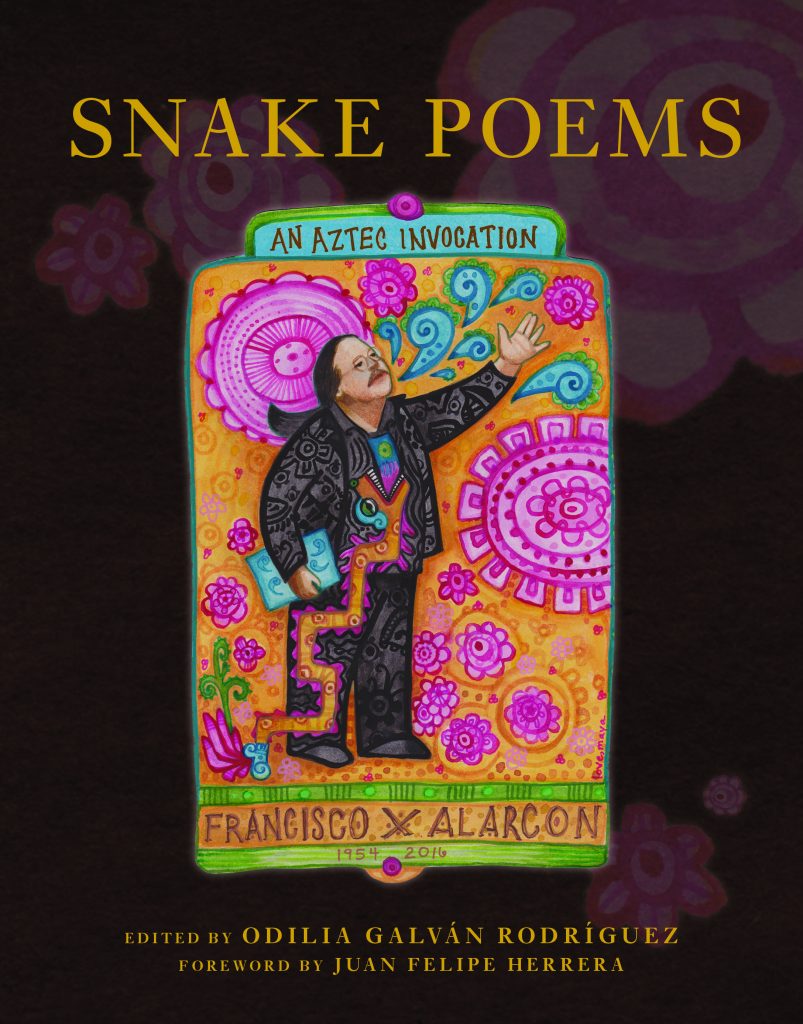February 21, 2019
The late Francisco X. Alarcón (1954–2016) was an award-winning Chicano poet and educator. He authored fourteen volumes of poetry, published seven books for children through Lee & Low Books, and taught at the University of California, Davis, where he directed the Spanish for Native Speakers Program.
He was a poet who lived beyond borders. His poetry straddled cultures and bridged generations. His words are carried on in the spark he ignited in the great many readers, fellow writers, and dreamers his life touched.
For beloved writer and mentor Francisco X. Alarcón, the collection Snake Poems: An Aztec Invocation was a poetic quest to reclaim a birthright. Originally published in 1992, the book propelled Alarcón to the forefront of contemporary Chicano letters.
This spring, the University of Arizona Press is honored to release a special edition of Snake Poems as a tender tribute to Alarcón, who passed away in 2016. This edition includes Nahuatl, Spanish, and English renditions of the 104 poems based on Nahuatl invocations and spells that have survived more than three centuries. The book opens with remembrances and testimonials about Alarcón’s impact as a writer, colleague, activist, and friend from former poet laureate Juan Felipe Herrera and poet and activist Odilia Galván Rodríguez, who writes, “This book is another one of those doors that [Francisco] opened and invited us to enter. Here we get to visit a snapshot in time of an ancient place of Nahuatl-speaking ancestors, and Francisco’s poetic response to what he saw through their eyes.”
Today on Francisco X Alarcón’s birthday, we’re pleased to share scholar and renowned poet Alfred Arteaga’s thoughts on the collection and Alarcón’s enduring legacy:
This present collection is something much more than just another new volume by a contemporary poet. For as new as Snake Poems is, it is bound inextricably to the past. It is like the serpent of fire that opens up its mouth to meet its double at the center of the exterior ring of the Sun Stone commonly known as the Aztec calendar. This text by Californian poet Francisco X. Alarcón is an encounter with another test completed in 1629 by one Hernando Ruiz de Alarcón, a Catholic parish priest from Atenango, a small town in the present state of Guerrero, Mexico.
The poetry of Snake Poems emerges as an encounter with the Ruiz de Alarcón’s colonial manuscript on Native American beliefs, Tratado de las supersticiones y costumbres gentílicas que hoy viven entre los indios naturales desta Nueva España (Treatise on the Superstitions and Heathen Customs That Today Live Among the Indians Native to This New Spain). Ruiz de Alarcón labored more than ten years compiling, translating, and interpreting the Nahuatl spells and invocations. The only extant copy of the handwritten Tratado is now found in the Museo Nacional de Antropología in Mexico City.
Ruiz de Alarcón’s Tratado was compiled a hundred years after the Spanish conquest of Mexico and remains one of the most important sources on Native religion beliefs and medicine. Its importance lies in the spells, curing practices, and myths that were transcribed in the original Nahuatl, the language of the Aztecs. It is this language transcription that allows so much of the original speakers to come to us today, despite the compiler’s insidious intent. Simply stated, Ruiz de Alarcón wrote on a mission for the Christian God, to expose heathen practice among the Indians and to extend the repressive practice of the Spanish Inquisition in Mexico. To gather the raw data for his catalog of practices, the author did not stop short of torturing his informants. Ruiz de Alarcón was admonished for his overzealous interview techniques and yet was able to finish his work undisturbed. Ironically, he was even promoted to ecclesiastical judge because of the extreme zeal of his faith.
What Francisco X. Alarcón has captured from the Tratado in Snake Poems is the spirit of the Indian informants, a sense of Native culture alive, despite efforts to misread and suppress it.
Francisco X. Alarcón’s poems reflect the worldview and belief systems of Indians of Mexico three and a half centuries ago. But clearly, Snake Poems is poetry, not ethnography, and the reflection it casts of the Tratado is nowhere near a mirror image. It is good that this is so. The poems are poems that stand as such, completely on their own. What Francisco X. Alarcón has captured from the Tratado in Snake Poems is the spirit of the Indian informants, a sense of Native culture alive, despite efforts to misread and suppress it.
Commentators on the Tratado frequently mention Ruiz de Alarcón’s poor translation and weak evaluation of some spells in Nahuatl, which seem only guided by his religious prejudice and cultural bias. Francisco X. Alarcón reads through the Tratado, past the surface prepared for the Inquisition, down to the living speakers, whose spells and chants and beliefs are recorded, down to Martín de Luna, Mariana, Domingo Hernández, Magdalena Petronila Xochiquetzal, and other named Indians. And while their words can only come by way of Ruiz de Alarcón, Snake Poems reflects the gaps, the lacunae, the interstices of cultural survival.
All quotations and references that appear in Snake Poems come directly from Ruiz de Alarcón’s Tratado, with five very telling exceptions. There is an invocation by the Mazatec María Sabina and a quote from the New Mexican weaver Agueda Martínez. There are allusions to living poets, to the Chicanos Tino Villanueva and Lucha Corpi and the Nicaraguan poet, priest, and former Sandinista Minister of Culture Ernesto Cardenal. For Francisco consciousness survives not only in the collective memory but also in the live words of the descendants of the original Indian authors. So, while the poem “Mestizo” celebrates the many strands that meet the hybridize in New World people, the epigraph by Agueda Martínez grounds identity very clearly, “ya que seamos hispanos, mexicanos; somos más indios”: more than Hispanics or Mexicans, we are Indians.
There are 104 Snake Poems, not an arbitrary number but one chosen for its significance in Native thought. The Mesoamerican calendar is based on a fifty-two-year cycle: half of 104. It is as if one cycle was completed with the first translation of Nahuatl thought, Ruiz de Alarcón’s Tratado, and the second cycle occurs now with Snake Poems. The first section of Snake Poems, “Tahui,” contains twenty poems, one for each day of the Mesoamerican month. The final section, “New Day,” contains six poems, alluding to the new era of the Sixth Sun.
The poems are spare in line length and in language. Nothing is wasted; very much is said. On the page, some of the poems appear long and lean like serpents on the desert floor. And there are the illustrations that somehow seem as much at home beside English and Spanish as they do beside Nahuatl. Beside the epigraph of Tino Villanueva’s invocation to Tlacuilo, there is the image of the writer, the speaker, making words. Image and form intertwine with the voices and languages of the past and present: a poetics of ancient oral magic and modern verse. Snake Poems is alive with a simultaneously present and past passion and concern; it brims with the spirit of those who sang despite the fact that their very songs could lead to punishment and death.
Read these poems as expressions of life, as a celebration of the Native heritage of Mestizo America. Some poems uplift and some are humorous, and when taken together, they sing in collective spirit, vigorous, denying death. But then: stop reading, put your ear to the page, and hear the faint yet persistent echoes. I do.
Alfred Arteaga
English Department, University of California, Berkeley
 The University of Arizona Press
The University of Arizona Press



